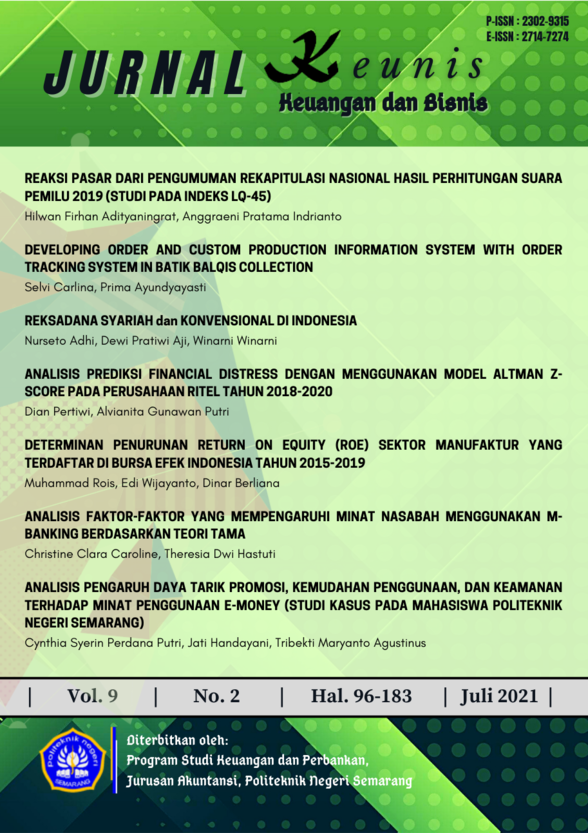ANALISIS FAKTOR-FAKTOR YANG MEMPENGARUHI MINAT NASABAH MENGGUNAKAN M-BANKING BERDASARKAN TEORI TAM
DOI:
https://doi.org/10.32497/keunis.v9i2.2819Keywords:
Perceived ease of use (PEOU), perceived benefit (PU), attitudes (A), Subjective Norms (NS), interest in using (ITU), M-BankingAbstract
This study aims to determine the positive influence of Perceived Ease of Use (PEOU), Perceived Ease of Use (PEOU), Perceived Usefulness (PU), Subjective Norm (SN), Subjective Norm (SN) on Intention to Use (ITU), and To determine the positive effect of Attitude (A) on Intention to Use (ITU). The sample is 207 respondents using M-Banking in Yogyakarta. SEM AMOS is used and has an effect on attitudes (A) of M-Banking users, Subjective Norms (NS) have a positive effect on interest in using (ITU) M-Banking, Perceived ease of use (PEOU) has a positive effect on perceived benefits (PU). M-Banking, Perceived Benefit (PU) has a positive effect on Interest in Using (ITU) M-Banking, Subjective Norms (SN) has a positive effect on Perceived Benefit (PU) M-Banking, Subjective Norms (NS) there is a relationship with interest (ITU) ) M-Banking, Attitude (A) there is a relationship in (ITU) M-Banking.
References
Agustina, Usfatul Ika dan Mohammad Arief. (2015). Pengaruh Persepsi Manfaat dan Persepsi Kemudahan terhadap Sikap Penggunaan Layanan Internet Banking (Study Pada Komunitas Virtual E-Banking BCA). Jurnal Ekonomi Bisnis Tahun 20, Nomor 2, Juli 2015, hlm 53-138.
Alba, Joseph W & Hutchinson, J Wesley. (1987). Dimensions of Consumer Expertise. Journal of Consumer Research, Vol 13. Pp 411-454.
Ajzen, I. & Fishbein, M. (1980) Understanding Attitudes and Predicting Social Behavior Englewood Cliffs, NJ: Prentice-Hall.
Ajzen, I. (1991). The Theory of Planned Behavior. Organizational Behavior and Human Decision Processes, 50: 179-211.
Bateni. (2014). “The Influential Factors On Capital Adequacy Ratio In Iranian Banks”. International Journal of Economics and Finance Vol 6 No 11. Pp 108-116.
Calantone, R. J., Griffith, D. A. & Yalcinkaya, G., (2006). An Empirical Examination of a Technology Adoption for the Context of China. Journal of International Marketing, pp. 1-27.
Davis,F.D. (1989). “Perceived Usefulness, Perceived Ease of Use, and User Acceptance of Information Technology”. MIS Quarterly.Vol. 13 No. 5: pp319-339.
Fadlan, Abi dan Rizki Yudhi Dewantara. (2018). Pengaruh Persepsi Kemudahan Dan Persepsi Kegunaan Terhadap Penggunaan Mobile Banking (Studi Pada Mahasiswa Pengguna Mobile Banking Universitas Brawijaya). Jurnal Administrasi Bisnis (JAB). Vol. 62 No. 1 September 2018.
Fishbein, M, & Ajzen, I. (1975). Belief, Attitude, Intention, and Behavior: An Introduction to Theory and Research, Reading, MA: Addison-Wesley.
Gatignon, H. & Robertson, T. S., (1989). Technology Diffusion: An Empirical Test of Competitive Effects. Journal of Marketing, Issue 53, pp. 35-49.
Ghozali, Imam. (2011). “Aplikasi Analisis Multivariate Dengan Program SPSS”. Semarang: Badan Penerbit Universitas Diponegoro.
Husni, K., & Halim Fairol. (2016). The Intention to Use E-Money Transaction in Indonesia based on Tam and TPB Concept. Asia-Pacific Marketing Review, 3(1), 53”“57.
Jogiyanto, (2007). Sistem Informasi Keprilakuan. Edisi Revisi penyunt. Yogyakarta: Andi Publisher.
Keat, K.T. & Mohan, A. (2004). Integration Of TAM Based Electronic Commerce Models For Trust. The Journal Of American Academy Of Business. Cambridge.
Khaled. (2013). “Determinants Of Capital Adequacy In Commercial Banks Of Jordan An Empirical Study”. International Journal of Academic Research in Economics and Management Sciences. Vol 2 No 4. Pp 44-58.
Malhotra, N.K. (2012). Basic Marketing Research : Integration of Social Media. Jakarta : PT Index Kelompok Gramedia.
MeIasari, Cita, Suroso, Agus, Banani, Ade. (2018). Pengaruh Kepercayaan, Kegunaan, Kemudahan, Privacy Risk, Time Risk, dan Financial Risk terhadap Minat Penggunaan Mobile Banking Bank Muamalat. Performance: Jurnal Personalia, Financial, Operasional, Marketing dan Sistem Informasi, [S.l.], v. 25, n. 1, p. 11-23, jan. 2018. ISSN 2615-8094.
Pertiwi, Ni Wayan Dewi Mas Yogi dan Dodik Ariyanto. (2017). Penerapan Model UTAUT2 Untuk Menjelaskan Minat Dan Perilaku Penggunaan Mobile Banking Di Kota Denpasar. E-Jurnal Akuntansi Universitas Udayana. Vol.18. Hal : 1369-1397 ISSN: 2302-8556.
Ryan, Michael J. & E. H. Bonfield (1980), “Fishbein”™s Intentions Model: A Test of External a nd Pragmatic Validity,” Journal of Marketing, 44(Spring):82- 95.
Sheppard, B.H., Hartwick, J., dan Warshaw, P.R. (1988). The Theory of Reasoned Action: A MetaAnalysis of Past Research with Recommendations for Modifications and Future Research. The Journal of Consumer Research, Vol.15, No.3, Desember, pp.325-343.
Utami, S. S., & Kusumawati, B. (2017). Faktor-Faktor Yang Memengaruhi Minat Penggunaan E-Money (Studi pada Mahasiswa STIE Ahmad Dahlan Jakarta ). Balance, XIV(2), 30”“41.
Venkatesh, V., Morris, M.G., Davis, G.B., & Davis, F.D. (2003).User acceptance of information technology: Toward a unified view. MIS Quarterly, Vol. 27 No. 3, pp. 425”“478.
Wibiadila, Ikbar and , Dr. Noer Sasongko, SE, M.Si, Ak (2016) Pengaruh Kegunaan, Kemudahan, Risiko, dan Kualitas Layanan terhadap Minat Nasabah dalam Menggunakan Mobile Banking (Survei Pada Nasabah Bank Mandiri Kantor Cabang Solo). Skripsi thesis, Universitas Muhammadiyah Surakarta.
Downloads
Published
Issue
Section
License
KEUNIS is licensed under a Creative Commons Attribution-ShareAlike 4.0 International License.
Authors who publish with this journal agree to the following terms:
- Authors retain copyright and grant the journal right of first publication with the work simultaneously licensed under a Creative Commons Attribution-ShareAlike 4.0 International License that allows others to share the work with an acknowledgement of the work's authorship and initial publication in this journal.
- Authors are able to enter into separate, additional contractual arrangements for the non-exclusive distribution of the journal's published version of the work (e.g., post it to an institutional repository or publish it in a book), with an acknowledgement of its initial publication in this journal.
- Authors are permitted and encouraged to post their work online (e.g., in institutional repositories or on their website) prior to and during the submission process, as it can lead to productive exchanges, as well as earlier and greater citation of published work (See The Effect of Open Access).






